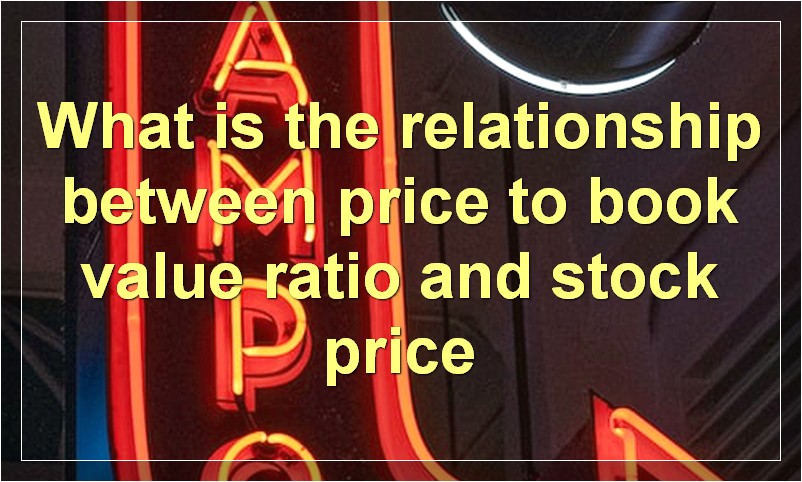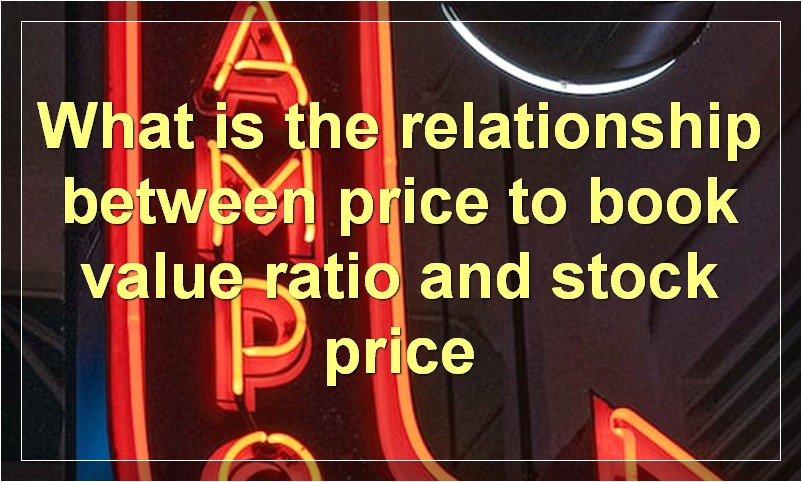Price to book value is a ratio used to compare a company’s current market price to its book value. Book value is an accounting term that refers to the value of a company’s assets minus its liabilities.
Investors use the price to book value ratio to find companies that may be undervalued by the market. A low price to book value ratio may indicate that a company is undervalued and could be a good investment.
What is the price to book value ratio
The price-to-book ratio is a financial ratio used to compare a company’s market value to its book value. The book value is the total value of a company’s assets, minus its liabilities. The market value is the current price of a company’s shares.
The ratio is calculated by dividing the market value per share by the book value per share. For example, if a company’s stock is trading at $100 per share and its book value is $50 per share, then its price-to-book ratio would be 2.0.
A high price-to-book ratio may indicate that a company’s stock is overvalued. A low price-to-book ratio may indicate that a company’s stock is undervalued. However, there are many other factors that should be considered before making any investment decisions.
What is the relationship between price to book value ratio and stock price

There is a strong relationship between the price to book value ratio and stock price. The price to book value ratio is a measure of the company’s share price compared to the book value of the company’s assets. A higher ratio indicates that the company’s shares are overvalued relative to its assets, while a lower ratio indicates that the company’s shares are undervalued relative to its assets.
This relationship is due to the fact that the book value of a company’s assets is a good indicator of the company’s intrinsic value. Therefore, if a company’s share price is trading at a high price-to-book value ratio, it is likely because investors believe that the company’s assets are worth more than their book value. On the other hand, if a company’s share price is trading at a low price-to-book value ratio, it is likely because investors believe that the company’s assets are worth less than their book value.
As such, the price to book value ratio is a useful tool for investors when determining whether or not a stock is overvalued or undervalued. If a stock is trading at a high price-to-book value ratio, it may be wise to avoid the stock, as it may be overvalued. However, if a stock is trading at a low price-to-book value ratio, it may be worth considering as an investment, as it may be undervalued.
How can price to book value ratio be used to identify undervalued stocks
The price to book value ratio (P/B) is a financial ratio used to compare a company’s stock market value to its book value. A lower P/B ratio could mean that a stock is undervalued.
To calculate the P/B ratio, divide the stock’s current market price per share by its book value per share.
For example, if a company’s stock is trading at $30 per share and its book value per share is $10, then its P/B ratio would be 3 ($30 divided by $10).
Investors often use the P/B ratio to identify companies that may be undervalued by the market. A low P/B ratio could indicate that a stock is trading below its intrinsic value.
However, it’s important to remember that the P/B ratio is just one tool in an investor’s toolbox. It’s important to look at other factors, such as earnings and cash flow, before making any investment decisions.
What are some of the limitations of using price to book value ratio
One of the key limitations of using price to book value ratio is that it does not take into account the company’s future growth prospects. In addition, this ratio also assumes that all of the book value is realized in the market, which may not be the case. Finally, this ratio may be misleading in industries where intangible assets make up a large portion of the book value.
How does the price to book value ratio compare across different industries
The price to book value ratio is a measure of how much investors are willing to pay for each dollar of a company’s book value. The book value is the accounting value of a company’s assets minus its liabilities. The higher the ratio, the more expensive the stock is relative to its book value.
Different industries have different average price to book ratios. For example, the average ratio for companies in the technology sector is around 4, while the average for companies in the utility sector is around 2. This means that, on average, investors are willing to pay $4 for each $1 of book value for a tech company, but only $2 for each $1 of book value for a utility company.
There are many reasons why investors might be willing to pay different prices for different types of companies. In general, investors tend to be willing to pay more for growth companies than for companies with more mature businesses. They also tend to be willing to pay more for companies with strong competitive advantages and positive future prospects.
Are there any stocks that have a high price to book value ratio but are still undervalued

There are a few stocks that have a high price to book value ratio but are still undervalued. One example is Apple Inc. (AAPL). Even though the stock is trading at around $120 per share, it still has a P/B ratio of only 3.8. This means that the stock is undervalued because the company’s book value is much higher than the current share price. Another example is Google Inc. (GOOGL). The stock is trading at around $750 per share, but it has a P/B ratio of only 5.3. This means that Google is also undervalued based on its book value.
What is the long-term average price to book value ratio for the stock market
It is often said that the stock market is a long-term investment. This is because the prices of stocks tend to go up over time, and the average price to book value ratio for the stock market is about 3.0. This means that for every $1.00 of book value, there are about $3.00 of market value. Over time, this ratio tends to increase, which means that the stock market becomes more expensive relative to book value.
This ratio is important to keep in mind when investing in the stock market. If you believe that the stock market is overpriced, then you may want to invest in other assets such as bonds or real estate. On the other hand, if you believe that the stock market is underpriced, then you may want to invest more heavily in stocks.
either way, it is important to remember that the long-term average price to book value ratio for the stock market is about 3.0. This means that over time, the stock market tends to become more expensive relative to book value.
What happens to a stock’s price to book value ratio when the company buys back shares
When a company buys back shares, the number of outstanding shares decreases. This has the effect of increasing the stock’s price to book value ratio. The reason for this is that the denominator in the ratio, book value per share, remains the same while the numerator, stock price, increases.
This increase in the price to book value ratio can be a signal to investors that the company’s management believes that the stock is undervalued. Buying back shares can also be a way for a company to return excess cash to shareholders.
If a company continues to buy back shares over time, eventually the stock price will exceed book value per share. At this point, the stock would be considered “overvalued” by some investors. However, if the company’s business continues to perform well, the stock price could continue to rise even after reaching this level.
If a company has a low price to book value ratio, does that mean it is a good investment
This is a difficult question to answer without knowing more about the company in question. Generally speaking, a low price to book value ratio could be a sign that the company is undervalued by the market. However, there are many other factors to consider before making an investment, such as the company’s financial stability, competitive landscape, and growth prospects.
What are some strategies for investing in stocks with a high price to book value ratio
When it comes to stocks, a high price to book value ratio (P/B) can be an indicator of a number of things. For one, it could mean that the company is doing well and its stock price has been driven up as a result. Alternately, it could also be a sign that the company is overvalued and may be due for a correction. As an investor, it’s important to do your research to determine which scenario is more likely in any given case.
With that in mind, here are a few strategies for investing in stocks with a high P/B ratio:
1. Look for companies with strong fundamentals. This means they have a solid track record of financial performance and are generally well-run businesses. These companies are more likely to be undervalued, even if their P/B ratios are high.
2. Avoid companies with high debt levels. A high P/B ratio can sometimes be a sign that a company is over-leveraged and may be at risk of financial distress.
3. Consider the company’s growth prospects. A company with strong growth potential may be worth investing in even if its P/B ratio is considered high.
4. Do your own research. As with any investment decision, it’s important to do your own due diligence before putting your money into anything. This includes reading annual reports, reviewing financial statements, and speaking to analysts to get their take on the company.

